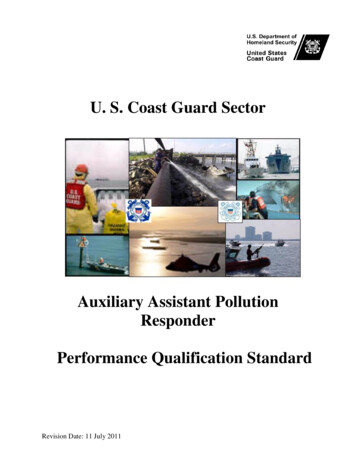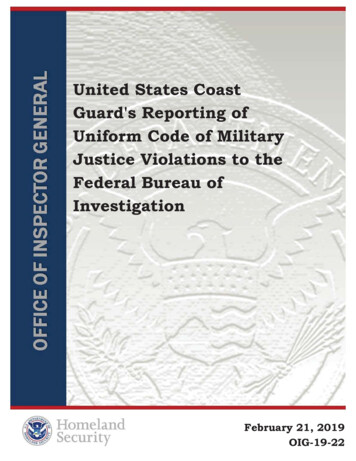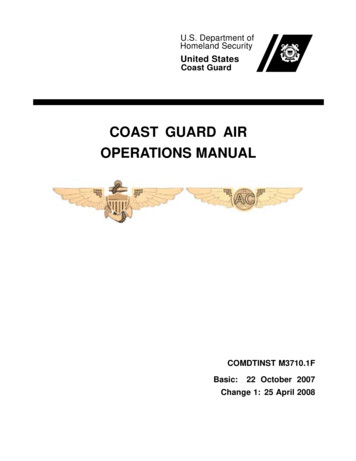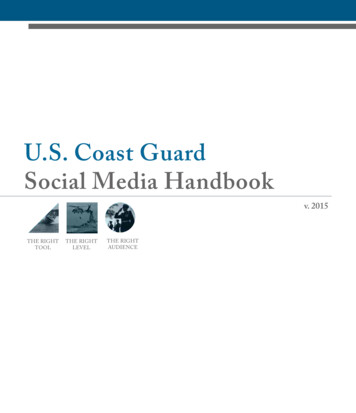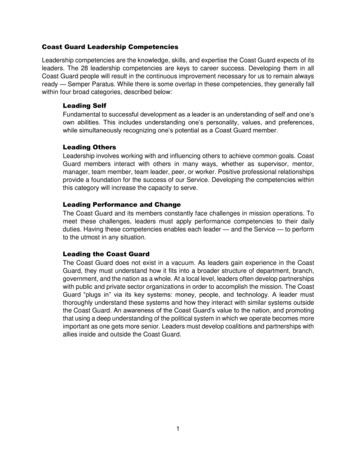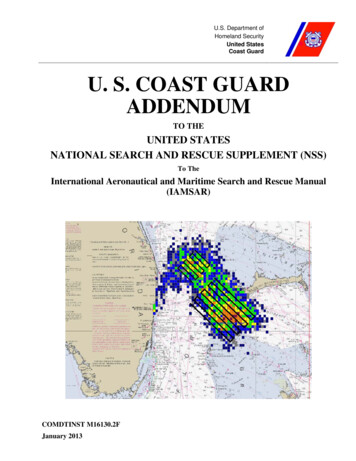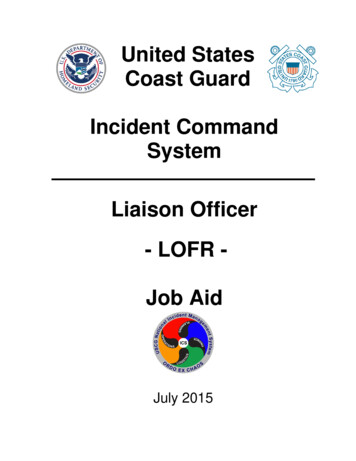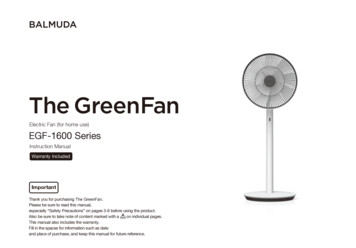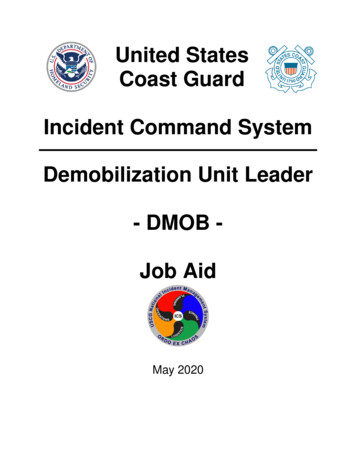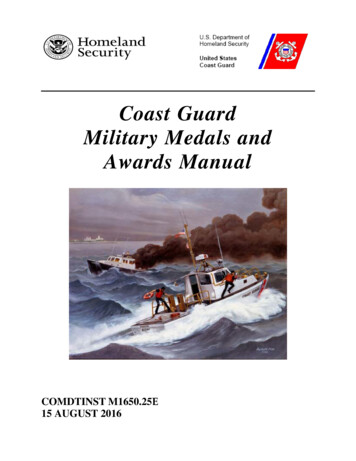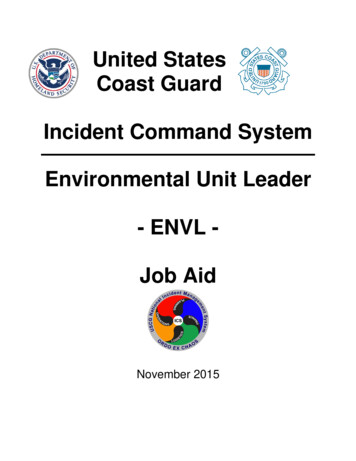
Transcription
United StatesCoast GuardIncident Command SystemEnvironmental Unit Leader- ENVL Job AidNovember 2015
ENVL Job AidEnvironmental Unit OrganizationEnvironmentalUnit Leader(ENVL)AssistantEnvironmentalUnit THSP)ReportProcessorsEnvironmental Unit CD2
ENVL Job Aid3Table of Contents1. Overview . 61.1. User . 61.2. When to Use . 61.3. Major Accomplishments. 71.4. References. 81.5. Materials and Forms . 91.6. Other . 10Checklists . 11Ready for Deployment Checklist . 11Ready for Operational Tasking Checklists . 11Manage Unit Personnel Checklist . 14Support the COP Checklist . 14Support the ICS Planning Process Checklist 15Demobilize Personnel and Unit Checklist. 152. Ready for Deployment - Pre-AssignmentActions . 162.1. Ensure personal readiness for assignment: 162.2. Ensure training and certification is current 172.3. Assemble ENVL Deployment Kit . 173. Ready for Operational Tasking . 183.1. Pre-Deployment Actions . 183.2. Check in to the Incident . 203.3. Obtain Situation Assessment. 233.4. Receive Initial Brief . 253.5. Activate Environmental Unit. 274. Manage Unit Personnel. 34
ENVL Job Aid44.1. Schedule Unit Meeting. 344.2. Provide OJT as appropriate . 344.3. Forecast requirements . 344.4. Evaluate and monitor unit performance 354.5. Evaluate personnel performance . 355. Manage the Common Operational Picture. 365.1. Information Management Process . 365.2. Identify environmental related CriticalInformation Requirements and Immediate ReportingThresholds . 385.3. Establish system for gathering/monitoringenvironmental data/information . 385.4. Verify/Synthesize/Analyze Information . 395.5. Report/Disseminate incident information tocustomers . 405.6. Establish system for management ofEnvironmental Displays . 415.7. Establish system for providing otherEnvironmental Unit support to IMT members 425.8. Manage schedule for collecting/disseminatingenvironmental information . 425.9. Compare environmental unit output withassessment of overall activities . 435.10. Maintain Documentation . 436. Support the ICS Planning Process . 456.1. Provide Environmental Briefings . 456.2. Provide Incident Action Plan support . 457. Demobilize Personnel and Unit . 46
ENVL Job Aid57.1. Provide input to the Demobilization Plan467.2. Review Approved Demobilization Plan . 467.3. Supervise demobilization of unit personnel 467.4. Supervise demobilization of unit . 468.Appendices. 488.1. Personal Mobilization Kit . 488.2. ENVL Deployment Kit . 488.3. Functional Interactions. 508.4. Example ICS 202B Critical InformationRequirements . 538.5. Example ICS 213 RR-CG Resource RequestMessage . 558.6. Example ICS 214 Unit Log . 578.7. Example ICS 214A-CG Chronology of EventsLog . 598.8. Example ICS 233 Open Action Tracker 618.9. Example Situation Status Display Board 638.10. Mapping Requirements and Guidelines 648.11. Map Display Symbology . 668.12. Unit Meeting Guidelines. 678.13. Environmental Unit Self-Eval Checklist 688.14. Personnel Evaluation Criteria . 698.15. ICS 225 Incident Personnel PerformanceRating. 708.16. ICS Planning Process . 72
ENVL Job Aid61.Overview1.1. UserThe user of this job aid will be anyone who isassigned as Environmental Unit Leader (ENVL)within the National Incident Management System(NIMS) Incident Command System (ICS).1.2. When to UseThis document is intended as a reference Job Aid toassist the ENVL in understanding the complex tasksand processes they may face with when the ICS isused. It is not a policy document, nor intended toact as or replace official policy, required training ordirection from higher authority. It is rather guidancefor response personnel requiring application ofjudgment.DISCLAIMER: This Job Aid is intended to provideguidance to Coast Guard personnel and is notintended to, nor does it impose legally-bindingrequirements on any party outside of the CoastGuard.Questions about this Job Aid should be directed tothe Coast Guard Office of ContingencyPreparedness and Exercise Policy (CG-CPE).
ENVL Job Aid71.3. Major AccomplishmentsThe ENVL’s primary responsibility is to collect,analyze and disseminate Common OperationalPicture information for the incident or event. Themajor accomplishments listed below support thiseffort and are expanded further into checklists in thisjob aid. Ready for Deploymento Pre-Assignment Actions Ready for Operational Taskingo Pre-Deployment Actionso Check in to the Incidento Conduct Situation Assessmento Receive Initial Briefo Activate Environmental Unito Develop Environmental Unit Processes Manage Unit Personnel and Activitieso Evaluate Staffingo Task and Employ
ENVL Job Aid8o Provide OJTo Support and Evaluate Personnel Support the Common Operational Pictureo Establish/Maintain the ENVL Displays, ifrequiredo Support SITL with the Information ManagementProcess (CIR/IRT) Collect Incident Information Organize and Evaluate Incident Information Disseminate Incident Informationo Provide Prediction and Modelingo Maintain Documentation Support the Planning Processo Provide Environmental Briefings and Forecastso Support the IAP Development Demobilize Unit and Personnel1.4. ReferencesBelow is a list of references that may be requiredwhile using this job aid. This list is not allencompassing. Links for many of these can befound at http://homeport.uscg.mil/ics/: Incident Management Handbook (IMH)COMDTPUB P3120.17 (series). USCG Information Management Job Aid National Incident Management System (NIMS) National Response Framework (NRF) USCG Type 3 Unit Leader Part A (CORE)
ENVL Job Aid9Performance Qualification Standard (PQS) USCG Type 3 Planning Unit Leader Positions PartB PQS Situation Unit Leader (SITL) Job Aid1.5. Materials and FormsA complete list of materials can be found in 0 ENVLDeployment Kit. Ensure these materials areavailable throughout the event. Submit request forsupplies in accordance with the incident’s resourcerequest process.All of the forms necessary to complete this job canbe found on the resource CD in the front cover ofthis job aid. These ICS forms can also be found onthe Coast Guard ICS web pages athttp://homeport.uscg.mil/ics/. Common forms theENVL will use include: ICS 201 Incident Briefing ICS 202 Incident Objectives ICS 202A Command Direction ICS 202B Critical Information Requirements ICS 203 Organization Assignment List ICS 204 Assignment List ICS 204A Assignment List Attachment ICS 205 Communications Plan ICS 205A Communications List ICS 206 Medical Plan
ENVL Job Aid10 ICS 207 Incident Organization Chart ICS 208 Site Safety and Health Plan ICS 209 Incident Status Summary ICS 210 Status Change Card ICS-211 Check-In List ICS 213 General Message ICS 213RR-CG Resource Request Message ICS 214 Unit Log ICS 214A Chronology of Events Log ICS 215 Operational Planning Worksheet ICS 215A Incident Action Plan Safety Analysis ICS 220 Air Operations Summary ICS 221 Demobilization Check-Out ICS 219 Resource Status T-Cards ICS 225 Incident Personnel PerformanceEvaluation ICS 230 Daily Meeting Schedule ICS 232 Resources at Risk ICS 233 Open Actions Tracker ICS 234 Work Analysis Matrix ICS 235 Facility Needs Assessment Worksheet ICS 236 Tentative Release List ICS 237 Incident Mishap Report1.6. OtherIn the context of this job aid, the word incidentmeans incident, event or exercise unless otherwisenoted.
ENVL Job AidChecklistsReady for Deployment ChecklistPre-Assignment ActionsEnsure personal readiness for assignment(See detail on page 16)Ensure ENVL certification is current(See detail on page 17)Assemble ENVL Deployment Kit(See detail on page 17)Ready for Operational Tasking ChecklistsPre-Deployment ActionsReceive assignment(See detail on page 18)Verify reporting location, date and time(See detail on page 18)Finalize personal readiness for assignment(See detail on page 18)Receive travel orders and order number(See detail on page 18)Make travel arrangements(See detail on page 19)Verify/Update personal deployment kit(See detail on page 19)Verify/Update ENVL deployment kit(See detail on page 19)11
ENVL Job Aid12Check in to the IncidentCheck-in on ICS 211 (See detail on page 20)Receive tasking (See detail on page 21)Check in with Finance/Admin Section(See detail on page 21)Check in with Logistics Section(See detail on page 21)Review Site Safety Plan(See detail on page 22)Obtain Situation AssessmentReview ICS 201 or IAP and Situation StatusDisplay (See detail on page 23)What kind of incident? (See detail on page 23)Who are key players? (See detail on page 23)When incident occurred?(See detail on page 24)Where is incident location/AOR?(See detail on page 24)What is the incident organization?(See detail on page 24)Obtain a meeting and briefing schedule(See detail on page 25)
ENVL Job AidReceive Initial BriefDefine your role (See detail on page 25)Obtain PSC expectations13(See detail on page 26)Determine any limitations and constraints(See detail on page 26)Activate Environmental UnitDetermine staffing requirements(See detail on page 27)Establish Environmental Unit work location(See detail on page 29)Organize and brief subordinates(See detail on page 30)Acquire work materials(See detail on page 30)Support Information Management Process(See detail on page 31)Establish initial internal and externalreporting requirements (see detail on page 32)Begin Support of ICS Planning Process(see detail on page 32)Begin/maintain ICS 214 Unit Activity Log andICS 214A-CG Chronology of Events Log(See detail on page 32)
ENVL Job AidManage Unit Personnel ChecklistSchedule unit meeting14(See detail on page 34)Provide On the Job Training (OJT) asappropriate (See detail on page 34)Forecast Requirements (See detail on page 34)Evaluate individual personnel performance(See detail on page 35)Support the COP ChecklistCoordinate with SITL the Environmental UnitSupport to the COP (See detail on page 38)Identify Critical Information Requirements andImmediate Reporting ThresholdRequirements for ENVL (See detail on page 38)Establish system for gathering/monitoringincident information (See detail on page 38)Verify/Synthesize/Analyze Information(See detail on page 39)Report/Disseminate incident information tocustomers (See detail on page 40)Compare environmental unit output withassessment of overall activities (See detail onpage 43)Manage schedule for collecting information(See detail on page 42)Obtain Feedback/Evaluate Performance(See detail on page 41)
ENVL Job AidSupport the ICS Planning Process ChecklistProvide Environmental Briefings asrequested (See detail on page 45)Provide Incident Action Plan support(See detail on page 45)Demobilize Personnel and Unit ChecklistProvide Input to the Demobilization Plan(See detail on page 46)Review Approved Demobilization Plan(See detail on page 46)Supervise demobilization of unit personnel(See detail on page 46)Supervise demobilization of unit(See detail on page 46)15
ENVL Job Aid162. Ready for Deployment - Pre-AssignmentActions2.1. Ensure personal readiness for assignment:If you deploy without being personally ready, it willaffect your ability to respond and cause a burden onthe incident management team. Personal readinessincludes: Medical/dental readinesso For military this means you are in the “green” inCG Business Intelligence (CGBI)o For civilians and auxiliarists, ensure you haveno outstanding issues that would prevent youfrom being deployed. (e.g. have a plan toensure you have enough medications for theentire period of the deployment) Uniforms – You have enough uniforms and/orappropriate clothing for an expected deployment Financial Readiness – You need to be financiallyready to deploy. This means ensuring yourfinancial situation is in order.o Government travel credit card (GTCC) – youshould check your GTCC limit. If you expect tobe deployed more than 30 days, your limitshould be increased (example from 2,500 to 10,000).o Ensuring bills will be paid while deployedo Ensure you have a TPAX account
ENVL Job Aid17 Family Readinesso Ensure you have a Dependent Care/Pet Careplan for when deployed. Please checkwww.militaryonesource.com for assistance.2.2. Ensure training and certification is currentEnsure ENVL training and certification is current asper COMDTINST(s) and PQS Mandated training ICS training (e.g. ICS-300, ICS-346) Incident specific training (e.g. HAZWOPER, areafamiliarization, etc.)2.3. Assemble ENVL Deployment KitEnsure all items found in 0 ENVL Deployment Kit are ready to go BEFOREyou get the call to deploy Ensure supplies are restocked from lastdeployment
ENVL Job Aid3. Ready for Operational Tasking3.1. Pre-Deployment Actions183.1.1. Receive assignment You may receive your assignment via message,phone call, supervisor, or on orders3.1.2. Verify reporting location, date and time You should verify reporting location, date andtime, order number, as well as Incident CommandPost (ICP) contact numbers for assistance withcheck-in3.1.3. Finalize personal readiness for assignment Review the pre-assignment check list to ensurereadiness for assignment which includespersonal, dependent, and financial readiness Notify your chain of command of any outstandingreadiness issues. This may mean delayingdeployment to resolve the issue.3.1.4. Receive Travel Orders and order number As per Federal Travel Regulations (FTR) a writtenorder issued by a competent authority is requiredfor reimbursement of travel expenses. Pleaserefer to the FTR to ensure all conditions are metwhen traveling under oral orders. The travel order number (TONO) and ordernumber are different. The order number will beused at check-in to verify the position that you will
ENVL Job Aid19be filling Order Number is generally in the following format:o Example: O374 (O is for Overhead, and the 3digit number is assigned by Logistics)3.1.5. Make travel arrangements Obtain counseling on entitlements andresponsibilities from a travel authorizing officialand review the FTR as necessary Request cash advances as required Make travel arrangements using approved CGtravel method3.1.6. Verify/update personal mobilization kit.See 8.1 Personal Mobilization Kit. A personalmobilization kit contains your personal items neededfor the deployment and includes items like: Medications Uniforms and/or appropriate clothing Special PPE or special weather clothing required Verify if any special PPE will be provided by theincident3.1.7. Verify/update ENVL Deployment kit Ensure manuals, forms and guides are currentversions (electronic and paper) Ensure supplies are restocked from lastdeploymentSee 0 ENVL Deployment Kit for list of items
ENVL Job Aid203.1.8. Obtain incident awarenessGather incident awareness if possible beforedeparting for the incident. This may include localarea knowledge, reviewing plans, and if possible theICS 201 or IAPs.3.2. Check in to the Incident3.2.1. Check-in on ICS 211:Upon arrival at the incident, check-in at the IncidentCommand Post on the ICS 211. Check In - Ensure you have your Order Numberavailable. This enables the Check-in Recorder(CHKN) to validate your assignment to the incidentquickly. In some cases the incident may be using the 16digit government TONO assigned to you as theOrder Number On some incidents, credentials (badges) arecreated for all assigned personnel. If the incidentis creating credentials, you should receive themwhen you check-in. The incident will want a number where you can bereached, your home base, how you got to theincident as well as any additional qualificationsyou may have
ENVL Job Aid213.2.2. Receive Tasking The check-in recorders should be able to tell youhow to get to the ICP or where you will be workingwithin the incident3.2.3. Check in with Finance/Admin Section Travel Orders: Leave copy of orders or other traveldocuments with FSC or Admin Officer. More oftenthan you realize, travel to an incident may takeplace on a unit TONO with the understanding thatthe incident will correct this when you arrive. Takecare of this soon so it doesn’t hold you up whenyou are ready to leave!3.2.4. Check in with Logistics Section Berthing assignment: The incident is responsiblefor ensuring you have adequate berthing, unlessyou are locally based. If the incident is small,Logistics may ask you to make your ownarrangements, or they may have alreadycontracted with a local hotel for incident personnel.Even if you have made your own arrangements,Logistics should still be tracking where personnelare berthed. Meal schedule: The size, complexity and locationof an incident will impact the availability of meals.On most Coast Guard responses, meals are theresponsibility of the individual. If meals areprovided; the incident generally tracks who got ameal and the individual is required to make the
ENVL Job Aid22appropriate modification to their travel claim. Consumables: Determine where to obtainnecessary materials for the unit (e.g. copy paper,pens, markers, etc.) Incident Credentials: On some incidents,credentials (badges) are created for all assignedpersonnel. If the incident is creating credentials,you should receive them when you check-in.3.2.5. Review the Site Safety Plan All overhead personnel and tactical resources(Operations personnel) must review the incidentspecific Site Safety Plan and sign the WorkerAcknowledgement Form A copy of the Site Safety Plan may be found atCheck-In, Staging Areas, and in the CommandPost in the Operations Section Chief and SiteSafety Officer’s work area On large incidents it may also be posted in areasnear the meal area and any other place largegroups of people will congregate Periodically review the Site Safety Plan to learnabout any additions and updates to the Plan
ENVL Job Aid233.3. Obtain Situation AssessmentThe following tasks should be accomplished afterchecking-in to the incident.3.3.1. Review the current ICS 201 and/or IAP The purpose of this task is to acquire additionalbackground on the incident prior to starting yourassignment Regardless of when you arrive at an incident thereis usually very little time for someone to brief you You need to find out the Who, What, When,Where, Incident Organization, and Resourcesrelated to the incident3.3.2. What is the incident (SAR, oil/hazmat, LE,natural disaster, etc.)? This gives you an idea of the resources thatshould be operating in theatre3.3.3. Determine the size and complexity of theincident: Determine incident complexity, Type 1, 2, or 3 Who are you working for (IC, UC, AC, NIC)? Is the incident expanding or contracting? Are there any political considerations to theincident?3.3.4. Who are key players (Federal, State, local,industry)? This may give you some insight into why
ENVL Job Aid24Command is setting particular objectives as wellas the boundaries of the incident Area ofResponsibility (AOR) One of the most important considerations to theIncident Management Team (IMT) is the localcommunity they are serving. Do you know whattheir goals/expectations of you are as the IMT?3.3.5. When did the incident take place? An incident changes character over timeincluding; survival rates, weathering of oil,potential contaminants, vessel stability, etc.3.3.6. Where did the incident take place? Do you know the unit Area of Responsibility(AOR)? If so, you have an advantage in knowingrelationships, geography, local plans, etc. If not,you must spend some time getting to know thearea. What is the difference between the unit AOR andthe incident AOR? Generally, there is adifference. Ensure you are aware of any community issues,sensitive areas, and endangered species withinthe incident AOR3.3.7. What is the incident organization?You must know who is in your direct chain ofcommand as well as other key players such as theIncident / Unified Commander(s) (IC/UC),
ENVL Job Aid25Operations Section Chief (OSC),Intelligence/Investigation Section Chief (ISC) - ifstaffed, Logistics Section Chief (LSC),Finance/Admin Section Chief (FSC), Liaison Officer(LOFR), and Safety Officer (SOFR)3.3.8. Obtain a meeting and briefing schedule When is the next meeting or briefing that shouldbe attended? Will you be required to present an environmentalbrief at any meetings/briefings?3.4. Receive Initial BriefThe initial briefing is the opportunity for the ENVL toreceive additional details about their incidentassignment. Depending on the phase and/or size ofthe incident, you may or may not get a chance tospend this time with the Planning Section Chief(PSC) and/or Deputy PSC before you start working.If you are NOT able to have this brief, you may beable to be briefed by the current ENVL or otherPlanning Section personnel.3.4.1. Define your role How big a role are you playing? Are you playingthe role of ENVL and another unit leader (multihatted)? Do you have the experience for the role you areplaying?
ENVL Job Aid26 Do you have authority from the PSC to requestresources?3.4.2. Obtain the expectations of the PSCPSC’s come with many different levels of expertiseand experience. In a multi-hazard, multijurisdictional incident it is possible that the PSCdoes not have expertise in Environmental Unitactivities. Your experience with a specific type of incidentgives you insight on information requirements,methods, and resources necessary to fulfill thoseexpectationso If you don’t have experience with the specifictype of incident, it would be to your benefit torequest personnel with that experience to serveas an Assistant ENVL At a minimum clarify the following expectationsfrom the PSC:o Does Command and/or PSC want a briefingfrom you on the process and procedures youtypically use as ENVL?o How often does the PSC want to be updated?o What are their trigger points?o What are the Immediate Reporting Thresholds?3.4.3. Determine any limitations and constraints Staff size
ENVL Job Aid Wall space Battle rhythm273.5. Activate Environmental UnitActivation of the Environmental Unit begins withmanagement of the unit (staffing and organizing theEnvironmental Unit workspace), but will also includesupporting the ICS Planning Process and supportingthe SITL who manages the information managementprocess.ManageSupportSupport theUnitInformationICS PlanningPersonnelManagementProcessProcess Staff Organize Manage Evaluate ENVLBriefings IAP Support Other3.5.1. Determine Staffing RequirementsThe table below refers to the USCG IMHOrganizational Guides found in Chapter 13 to
ENVL Job Aid28establish a baseline staffing requirement. Keep inmind the recommendations are based on 12-hourwork schedules and may need to be doubled forround the clock response.PositionAsst. ENVLDisplay ProcessorTechnical SpecialistsSize of incident (# ofDivisions/Groups)2 5 10 15 251 1 21 1 1 2As neededEnvironmental Unit Staffing WorksheetStaffShift #1Shift #2ENVLN/AAsst ENVLDPROTHSP - SpecifySub-TotalTOTALShift 1 & 2 The number of personnel needed may increase ordecrease based on the IMT information demand Consider the addition of Assistant ENVLs tomanage span of control within the unit (e.g.display processors and numerous technicalspecialists providing environmental data) Submit an ICS 213RR-CG in accordance with the
ENVL Job Aidincident resource requesting process Ensure your calculations consider 24 houroperations if necessary (i.e. double the tablenumbers for 24 hour operations)293.5.2. Establish a work location(s) Ensure adequate work space for number ofpersonnel and equipment including the possibilityfor expansion. A tool to determine space needscan be found on the ICS 235 Facility NeedsAssessment Worksheet. The Environmental Unit should be located withinthe Planning Section and in the vicinity of SituationUnit ENVL must coordinate with the SITL on theirdisplays. Is the Environmental Unit assisting withthe Situation displays, or in addition to situationdisplays? There are many possible locations forEnvironmental Displays and should be locatedvery close to or part of the Situation Unit Displaysand close to the Operations Section, your primaryaudience. If possible this should be accessible toother ICP personnel. If not, establish a satellitedisplay in a common (i.e. trafficked) space in theICP that is user friendly and highly visible to theIMT. See 8.9 Example Situation Unit StatusDisplay Board. Additional environmental displays may be required
ENVL Job Aid30by the IMT in the: JIC, Command meeting room,primary meeting space, VIP reception location,etc. Every additional display should generallyhave its own display processor assigned tomaintain and ensure current status. The ENVL must keep in mind the need forsufficient wall space to mount maps/charts, forms,photos, projected images, etc. including the needfor growth3.5.3. Acquire work materials Identify appropriate work materials based onEnvironmental Unit and Environmental Displaylocations. Submit an ICS 213RR-CG Resource Request inaccordance with incident resource requestprocess. See 8.5 Example ICS 213 RR-CGResource Request Message.3.5.4. Organize and brief subordinates Identify the immediate information demands (i.e.support to SITL for the Common OperationalPicture) and organize your personnel to meetthose demands until additional personnel report Conduct the initial unit meeting as outlined in 8.12Unit Meeting Guidelines to establish guidelines,expectations, work schedule, meeting schedules,customer needs, and display content andlocations
ENVL Job Aid31 Outline resource request process to subordinates Develop an Organization Chart for the unit toidentify roles and highlight span of control issues Evaluate the span of control with the unit andrequest/assign additional personnel to maintainproper management ratios (i.e. assignAssistant(s) or THSP(s))3.5.5. Support the Information ManagementProcessThe success of the Environmental Unit is measuredby IMT customer satisfaction with information flow,management, and availability. The Situation Unitoversees the Information Management Process andthe Environmental Unit supports them. See 5.1Information Management Process for moreinformation about the Information ManagementProcess. Setting expectations early with help defineyour success. Determine need for environmental displays fromSITL and PSC. SITL is responsible for thedisplays but the environmental unit can providemany of the products the SITL will need. See 8.9Example Situation Unit Status Display Board. Assign personnel to create environmental displayso Using standard ICS symbology. See 8.10Mapping Requirements and Guidelines and 8.11Map Display Symbology.o Ensure that Maps/Charts meet the STAND
ENVL Job Aid32principle: Scale, Title, Author, North Arrow, Dateand Timeo With input from SITL and/or OSC, determineand display the division/group boundarieso Display sensitive areaso Display projections (weather, spill, etc) ifavailable Validate current environmental information postedon the situation status board3.5.6. Establish initial internal and externalreporting requirements Understand the interactions the ENVL has withother IMT members, especially the Situation Unit.See 8.3 Functional Interactions for moreinformation. Establish a timeline comparison to ensure theEnvironmental Unit is able to meet thereporting/briefing requirements.3.5.7. Begin Unit DocumentationEnsure proper documentation is started for theEnvironmental Unit. This includes periodicdocumentation of the incident as it stands at aspecific time. Assign personnel to maintain running ICS 214ACG Chronology of Events Log, if appropriate. See8.7 Example ICS 214A-CG Chronology of EventsLog. Complete ICS 214 Unit Log. See 8.6 Example
ENVL Job Aid33ICS 214 Unit Log. Take pictures of charts/maps for documentationpurposes at a specific time3.5.8. Begin Support to the ICS Planning ProcessSee 6 Support the ICS Planning Process for moreinformation.
ENVL Job Aid344. Manage Unit PersonnelAfter initial set up of the Environmental Unit, theENVL must manage the unit and personnel.4.1. Schedule Unit Meeting At least one per operational period If necessary, one per Environmental Unit shift Brief subordinates on work assignments See 8.12 Unit Meeting Guidelines Post expectations for unit personnel to review Provide direction to staff4.2. Provide On the Job Training (OJT) asappropriate ICS position specific training Equipment training (vehicle, GPS, digitalcameras, office equipment, etc.) HAZWOPER4.3. Forecast requirements Future personnel requirements R
Incident Management Handbook (IMH) COMDTPUB P3120.17 (series). USCG Information Management Job Aid . Performance Qualification Standard (PQS) USCG Type 3 Planning Unit Leader Positions Part B PQS Situation Unit Leader (SITL) Job Aid 1.5.Materials and Forms A complete list of materials can be found in 0 ENVL Deployment Kit. Ensure these .
